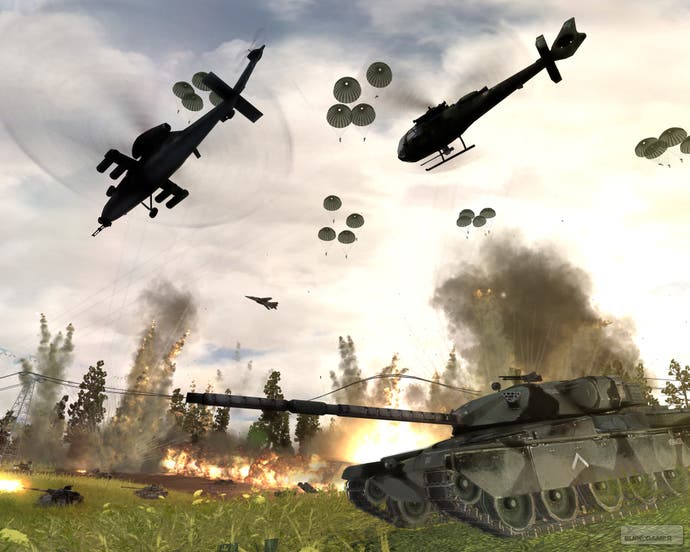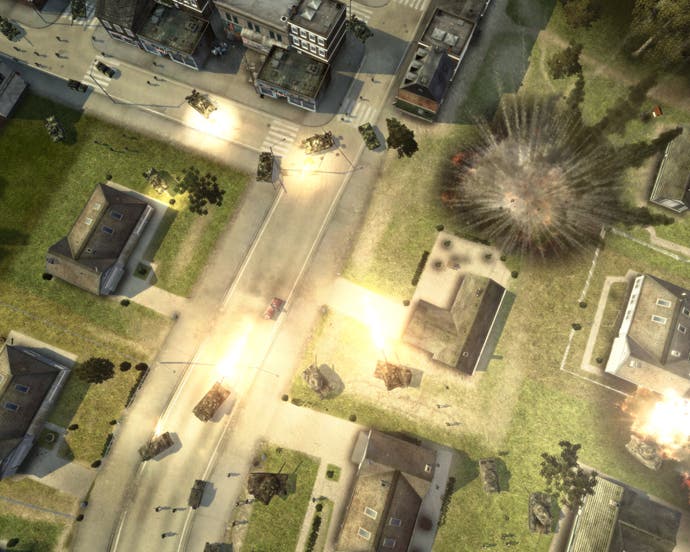World in Conflict
Nuke kids on the block.
I'm giving very serious consideration to the idea of detonating a small nuclear device in a major American city. Now that I've successfully made Eurogamer flash up on the screens of a dozen top secret US intelligence agencies (Kristan may be spirited away to some officially-denied torture dungeon, but just think of the page views!) I should probably explain that, ho ho, I'm just talking about the latest real-time strategy game to set PC hearts a-flutter.
Of course, everybody already knew that since World in Conflict arrives under the considerable burden of being known as "that explosions game where you get to use nukes". While the astonishing pyrotechnics are certainly eye-catching, it'd be a shame if the game were to be remembered solely for its big bangs, luminous walls of flame and rolling banks of realistic smoke and ash. Take away the apocalyptic bluster, and World in Conflict is still one of the most indecently absorbing PC games of the year.
That doesn't mean, however, that it's particularly original or groundbreaking. In terms of features, there's little here that strategy fans won't have seen elsewhere - most notably in the sci-fi Ground Control series, where Swedish developer Massive first attracted praise. The high concept here, that Soviet forces invade the United States in 1989, adds an interesting alternate-history wrinkle to the tanks-and-infantry template but what really makes World in Conflict grab you by the mansacks is the execution. It's immediate. Streamlined. Visceral. It plays like a strategy game, but feels like an action game.

While other RTS games, such as the monolithic Supreme Commander, have pulled further and further away from the blood and rubble of the battlefield, Massive has always stayed close to the action. Harvesting and resource management is most assuredly not on the agenda here. With a Soviet sniper picking off your explosives experts before they can bring down a key structure, you won't be distracted by how many paperclips you need to order for the War Office. In World in Conflict, you're not some high-minded mastermind overseeing the entire war, but a mid-level corporal following orders in a dirty urban scramble for survival. Battles will rage around you - AI allies and foes slugging it out on street corners, artillery fire raining down from both sides - but you've got to barrel on through. Don't engage every enemy you see. Don't assist every friend in need. Your task is focussed and clear. Fulfil your objectives, and do as you're told. Victory doesn't come from destroying every last enemy onscreen, it comes from holding them back just long enough to receive the next order. As you pull out and move on, computer controlled allies roll in to take your place. The illusion of being part of a larger, ongoing battle is terrifyingly real.
Rather than making the game frustrating and linear, this actually frees you up to indulge in some real real-time strategy. It's meat and potatoes military strategy at the frontline. How do you secure and fortify a town square against a platoon of heavy tanks, mere minutes away? How do you react when that force is joined by helicopters from the east and anti-tank infantry from the west? Can you spare the resources to deal with the enemy artillery over that hill? Will that carpet bomb you just called in obliterate enough of the advancing hordes for you to survive by the skin of your teeth? There's no time to mull it over, you just have to grab the units you have, send them into action as best you can and think on your feet every step of the way. And it's breathlessly exhilarating.

Single player campaigns are broken up into seven or more primary objectives, with optional secondary objectives cropping up as you move through them. Taking, fortifying and holding strategic command points is the meat of the game, but the circumstances of each objective vary enough that the task never feels repetitive. While a campaign may take an hour or more, it'll be broken down into smaller engagements where simply crossing a river or destroying one building requires careful planning. Maps are insanely detailed - witness the snowy footprints your troops leave in Cascade Falls, discarded Christmas decorations littering the streets - but of manageable size. You'll rarely be commanding more than ten units, and even when you split them up, they'll always be within range of each other. This isn't a game where you need to zoom up into the heavens to see where everyone is. Your camera hovers at roof level, roaming realistic streets looking for tactical advantages.
The top right of the screen is home to your reinforcements menu, from which you can call in whatever combination of vehicles and troops you like. Your choices are limited only by the number of reinforcement points you have - more are awarded for successful play, and when a unit is destroyed, its point value goes back into the queue and can be spent again after a certain amount of time. This clever mechanic means you'll never be left high and dry, at least in theory, but poor judgment and timing can still leave you defending the line with a handful of soldiers and one knackered tank. It puts the onus on you, the player, to make best use of what you have, planning on the fly not only for the current engagement, but for whatever comes rolling down the street next.









